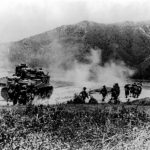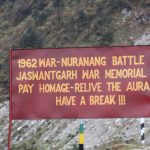The Legend of Saragarhi
Bravery Unrivalled
The Hindu Kush Ranges: It’s not a name that we hear often nowadays; but not so in late 19th Century. It was the era of the ‘Great Game’ wherein the British and the Russian Empires vied with each other to gain supremacy in Central Asia. Afghanistan, the middle ground for these two powers, assumed strategic significance with both trying to exert their influence over the country through incursions and alliances with the tribesmen who controlled it. India faced a constant threat of invasion by tribesmen allied to Russia. The Hindu Kush Ranges of the North-West Frontier formed the country’s forward line of defence and was to witness sporadic but bloody fighting for almost a 100 years from mid 19th to mid 20th Century, in what came to be collectively called the Frontier Wars. The ranges were spotted by a series of outposts built by Maharaja Ranjit Singh during his western campaign, which had been taken over by the British following the decline of the Sikh Empire after the Maharaja’s reign and were now manned by British and Indian troops. They faced a barbaric enemy who was as notorious for his cruelty as was renowned for his ferocity in battle. The tribesmen, lacking the soldierly traits of chivalry and discipline, revelled in torturing their prisoners, committing untold atrocities from castration and mutilation to skinning them alive. They used it as a psychological weapon to terrorize their enemy soldiers.
Saragarhi is a small village in the border district of Korat in present-day Pakistan. During the Frontier Wars a relay post had been built there to maintain communication between two major outposts, Fort Lockhart in the Samana Range and Fort Gulistan in the Sulaiman Range of the Hindu Kush, which were out of sight of each other because of intervening features. Situated on a rocky ridge the post consisted of a small block house with loop-holed ramparts and a signaling tower. Messages were transmitted from the signaling tower by means of a heliograph, a type of equipment which captured sunlight with mirror and used it for coded communication. On 12 September 1897 the post was manned by a 21-man detachment of Bengal Infantry’s 36th Sikh (present-day 4th Battalion, The Sikh Regiment of the Indian Army) under Havildar Ishar Singh, a Frontier Veteran of many years. In the days leading to 12 September the belligerent tribesmen had made repeated attempts to overrun Saragarhi so as to disrupt the communication between the two forts of Lockhart and Gulistan and render them both untenable to hold. Ishar Singh and his men had doggedly held fast repulsing one attack after another. Then the Pashtuns of the Afridi and Orkzai tribes contrived a grand plan to blockade Fort Lockhart, the closest support base for Saragarhi, so that no reinforcements from there could reach the post; and then mount an attack on it with a massive 10,000-man force.
With the blockade in place, the tribesmen struck at 0900 hours on 12 September. Havildar Ishar Singh watched the approaching enemy horde through his binoculars from the watch tower of his post. It was a formidable sight. Row after row of horsemen advanced steadfastly in the cloud of dust their mounts’ hooves kicked up, menacingly waving their swords and guns. Ishar Singh was too experienced a soldier to panic. Keeping his cool he called his command to stand to and ordered the detachment signaler, Sepoy Gurmukh Singh, to alert Fort Lockhart. Gurmukh Singh, a 19-year old lad, set up his heliograph and sent out a signal to the Fort, “ENEMY APPROACHING THE MAIN GATE. NEED REINFORCEMENT”. Lieutenant Colonel Haughton, the Commanding Officer of the 36th Sikh, was quick to respond with a sortie to reach his beleaguered detachment, but to no avail. The tribesmen had effectively cut off the route to Saragarhi.
“UNABLE TO BREAKTHROUGH. HOLD POSITION”, the signal from Fort Lockhart to Saragarhi read. “UNDERSTOOD” the post signalled back and with that the battle lines were drawn. Haughton, observing from his position at Fort Lockhart could count at least ten standards in enemy’s ranks, each representing a1000 tribesmen each. He passed on the information to Gurmukh Singh at Saragarhi. Havildar Ishar Singh absorbed the information his young signaler fed him with equanimity and ordered the bugle to be sounded for the battle to commence. The detachment formed up in a jiffy two line abreast one kneeling to firing position in front and the other standing back as per the drill.
The howling hordes of enemy charged at the post’s main gate in a frenzy. The detachment held back its fire. The Martini Henry breech loading rifles the men were equipped with had been issued to them only a few months ago, but they had mastered the use of it in the short span. The antiquated muzzle loading rifles the tribesmen flaunted, the men knew, were no match for this new weapon of theirs capable of firing ten 0.303 rounds in a minute. It had an aimed effective range of 600 yards; but Ishar Singh restrained the men from opening fire till the attackers were within 250 yards, to be doubly sure that each shot counted. A father figure to his men the leather-hard old havildar commanded their absolute respect and loyalty. They won’t let him down, neither would he them. Once the enemy frontline crossed the 250-yard marker in his judgment Ishar Singh’s command rang out, “FIRE…….RELOAD………FIRE AT WILL”. A thundering volley of the Martini Henrys boomed out as scores of charging horsemen were mowed down. The attack was halted on its tracks as if it had run into a wall of steel. The fight however had just begun. The enemy was just testing the waters, assessing the defenders’ strength. Ishar Singh watched them come again from atop his post, murderous hordes of them.
The tribesmen fanned out as they charged heading for the flanks in a multi-pronged attack. Ishar Singh’s commands rang out again, stoic and calm, directing his men to cover the flanks and they responded with clock-work precision in a staunch display of discipline and professionalism. The enemy went at it hammer and tongs; one group attacking the main gate while another went for a gap in the fortification. Once again the superior marksmanship and discipline of the soldiers prevailed and the attack was repulsed. There was no respite however. Attack after attack continued on the post, wave after wave of tribesmen charging forward in desperate fervour, only to be beaten back by the spirited defence the soldiers put up every time. However the intense fighting, often at close quarters as was evident from many of the enemy’s dead strewn right close by, was taking its toll on the defenders too. By 1200 hours the garrison had withstood 7 fanatical charges but had been reduced to less than half its strength with only 10 men standing. Havildar Ishar Singh himself had been wounded, but was still leading the men. Their ammunition stock was dwindling too.
“LOW ON AMMO…….NEED AMMO………URGENTLY”, a distraught message from Saragarhi to Fort Lockhart read. Lieutenant Colonel Haughton wrung his hands in despair. He made a last-ditch bid to get a courier across, but it came to nothing. Meanwhile Ishar Singh and his men beat back yet another attack. By now the garrison was in a precarious state; a handful of diehard soldiers practically out of ammunition trying to hold an avalanche of fiery tribesmen. The tribesmen probably counted on the soldiers in the post to be overwhelmed by the repeated attacks and surrender. That was not going to happen. Each soldier in the garrison was a Sikh and surrender was an act of cowardice to him and a desecration of the holy tenet of his religion. To a man, the whole garrison would abide by the tenets of Sikhism they were sworn to and die fighting rather than lay down their arms. They very well knew they were facing the ultimate test and what the outcome would be.
The Pashtuns, tired of being mauled in the blunt attacks, devised a ruse. They set the bushes and scrubs around the fort on fire and approached the fort under cover of the smoke. Instead of the main gate they headed for the lone breach the fort had. Troops watching from their higher point at Fort Lockhart could see the move. “ENEMY APPROACHING THE BREACH”, Fort Lockhart signaled Saragarhi frantically. Ishar Singh, badly wounded, dragged himself to the breach with two sepoys. Out of ammunition the trio charged at the horde of Pashtuns gushing in with fixed bayonets. Inevitably all three were overwhelmed and cut down fighting till their last breath. Even as the fight raged at the breach, the enemy broke through the main gate, which had only few men left to defend it. It was a melee now with the tribesmen crowding the fort. Barely four Sikhs were alive; but they stood back to back with each other forming a box with bayonets thrust forward and fought on. Over a hundred blood-thirsty Pathans fell on them and hacked them to pieces, but not before they had taken a few enemy heads themselves. British and Indian soldiers watching from Fort Lockhart were awe-struck by this unbelievable act of valour being enacted in their plain sight. It was bravery at its noblest best. No body of troops could give more. Amidst the dust and din of the battle the troops at Fort Lockhart could hear the Sikh Battle Cry reverberating across the air till the end, “JO BOLE SOL NIHAL SAT SRI AKAL”.
Sepoy Gurmukh Singh, the young signaler, who had all this while been assiduously updating Fort Lockhart with situation reports from his elevated position, transmitted at 1530 hours, “MAIN GATE BREACHED….DOWN TO ONE…..REQUEST PERMISSION TO DISMOUNT AND JOIN THE FIGHT”. His orders were not late in coming. “PERMISSION GRANTED”. Gurmukh Singh, the youngest soldier of the detachment, dismantled his heliograph device, picked up his rifle and went down to the fort and the fight; the last to join. He went at it with incredible tenacity. Troops at Fort Lockhart saw him disappear into the mass of tribesmen but could hear his repeated battle cries as he stood there alone bayoneting all around, in a grand finale to a magnificent feat of arms. Legend has it that he took down 20 tribesmen on his own before they could get him, his defiant battle cries fading as life ebbed out of his young body. He breathed his last contented that he had done his duty, the last of the Saragarhi’s brave-hearts to lay down his life and find his place in posterity with the remaining 20 of his comrades.
The crucial 7 hours during which the valiant 21 of Saragarhi held their post against overwhelming odds gave the British the badly needed breather to reinforce their two forts with more men and artillery which prevented them from falling into enemy hands. By the time the Pashtuns were able to mount an attack on Fort Gulistan, the garrison there, reinforced and ready, was able to repulse it. Troops from that fort retook Saragarhi on 14 September. They found the burnt out bodies of all the 21Sikhs. They also found at least 600 bodies of slain tribesmen strewn all over. While some of the tribesmen could have been killed in the intense shelling from Fort Gulistan in the engagement to retake the place, there was no doubt that Ishar Singh and his men had accounted for a large number of enemy casualties (180 by Pashtun accounts itself). The 21 Sikhs at Saragarhi had been outnumbered by almost 1: 500, the greatest odds faced by troops anywhere in the history of warfare.
The tale of the heroic last stand of the gallant 21 at Saragarhi was flashed across the Indian and British establishment within hours. In London the House of Commons paid a standing ovation to their outstanding act of valour unmatched in the history of British Arms. In an unprecedented gesture Queen Victoria decreed that all the 21 be awarded the Indian Order of Merit (IOM), the highest gallantry award given to colonial troops then and equal to the Victoria Cross. It was the first time ever all participants in a single battle were honoured with the highest gallantry award. A memorial cenotaph was erected at the site of the battle with the names of all 21. To commemorate the battle the British Government also built two Saragarhi Gurudwaras, one at Amritsar close to the entrance of the Golden Temple and another at Ferozepore, the district which most of the Saragarhi heroes hailed from. Since 2013 the British Army commemorates Saragarhi on its Battle Honour Day at the Royal Military Academy, Sandhurst. The Sikh Community all over the world commemorates the immortal feat by observing 12 September every year as Saragarhi Day. And the Sikh Regiment honours their valiant 21 by observing 12 September as their Regimental Day.
Many draw comparisons between the Battle of Saragarhi and the Battle of Thermopylae wherein 300 Spartans made their last stand against 60,000 Persians in BC 480. The odds faced by the 21 Sikhs of Saragarhi were actually higher. French Schools have the Battle of Saragarhi in their curriculum to exemplify the virtues of devotion to duty and sacrifice. UNESCO has since listed it as one of the 6 tales of collective bravery the world over. But alas, in India most of our children haven’t even heard about it! Cry, my beloved country!!
[The author acknowledges a research paper published on the internet ‘The Gallant 21: Saga of the Sikh Soldiers at Saragarhi’ by Jeyaganseh Gopalsamy, LLB (HONS) WALES, MA (STRATEGY) UKM as the primary source of information for this article.]





Just wish to say your article is as surprising. The clarity in your post is simply great and i could assume you are
an expert on this subject. Fine with your permission let me to grab your feed
to keep updated with forthcoming post. Thanks a million and
please keep up the gratifying work.
Thank you.
My family members all the time say that I am wasting my time here at web, however I know I am getting familiarity every
day by reading such pleasant content.
Thank you; we’re gratified.
This website was… how do you say it? Relevant!! Finally
I’ve found something which helped me. Appreciate it!
Thanks a lot. Do keep visiting.
Howdy just wanted to give you a quick heads up and let you know a few
of the images aren’t loading correctly. I’m not sure why but I think its a linking issue.
I’ve tried it in two different browsers and both show
the same results.
Yes, but that was in just one or two cases when there was a zooming problems; we’re trying to sort that out. Thank you for observing.
I am curious to find out what blog platform you
happen to be working with? I’m experiencing some small security
issues with my latest blog and I would like to find something more safeguarded.
Do you have any recommendations?
I’m not technically very proficient on this. You could probably consult my website manager, Mr. Murugan. His email id is: ms@muruganselvaraj.com